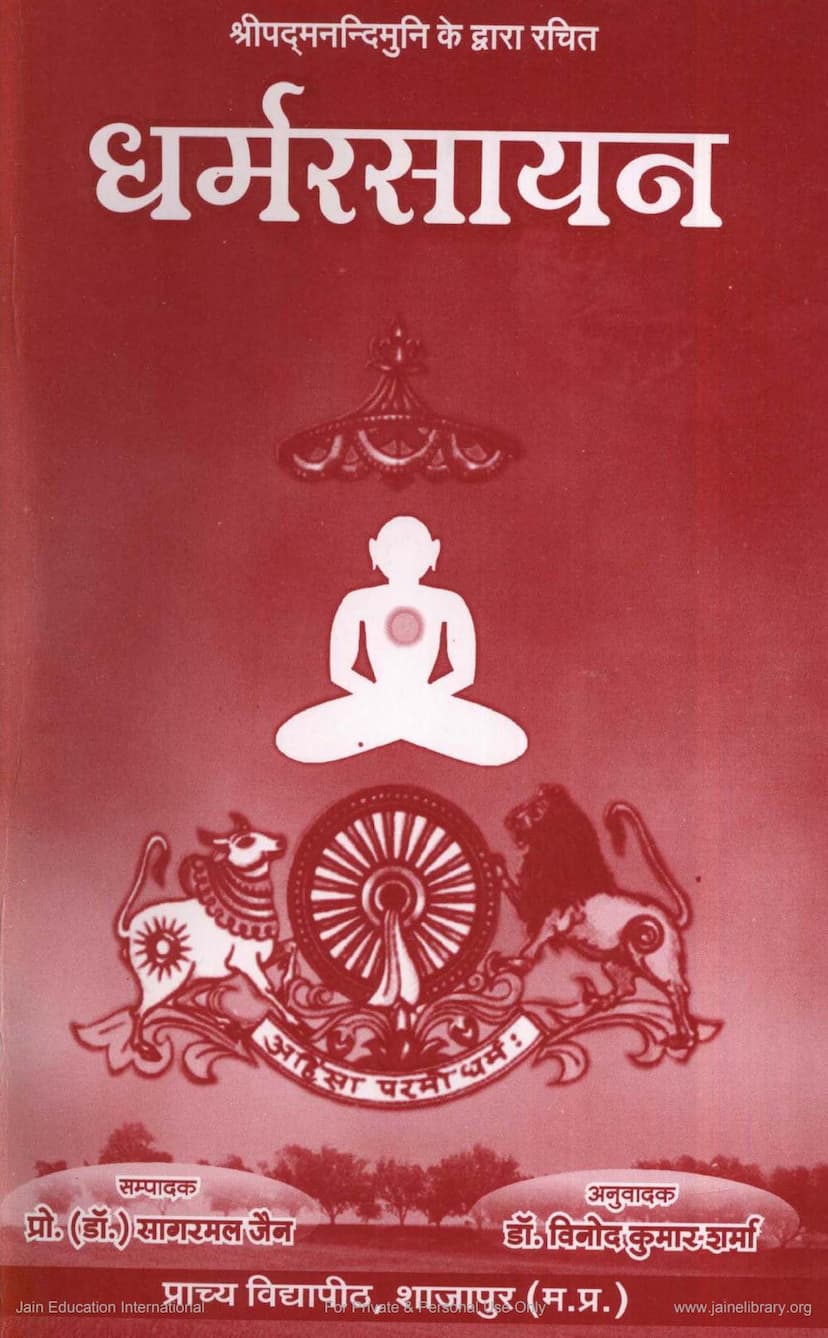Dharmrasayana
Added to library: September 1, 2025
Loading image...

Summary
This summary details the Jain text "Dharmrasayana" by Muni Padmanandi, translated by Dr. Vinod Kumar Sharma and edited by Prof. (Dr.) Sagar Mal Jain.
Key aspects of the "Dharmrasayana":
- Title: "Dharmrasayana" (धर्मरसायन) meaning "The Essence of Dharma" or "The Elixir of Dharma."
- Author: Muni Padmanandi (श्री पद्मनन्दि मुनि)
- Publisher: Prachya Vidyapith Shajapur (प्राच्य विद्यापीठ शाजापुर)
- Language: Composed in 193 Prakrit verses (गाथाएँ). The language is identified as Prakrit influenced by Maharashtri Prakrit, not strictly Shauraseni or Ardhamagadhi.
- Content: The book's primary aim is to elucidate the nature of Dharma. It is structured into 16 chapters covering:
- Invocation (Mangalacharan)
- Glory of Dharma
- Distinction between Dharma and Adharma
- Description of the Naraka (Hell) realm
- Description of the Tiryanch (Animal) realm
- Description of the Kumanushya (Evil Human) realm
- Description of the Deva (Celestial) realm
- Examination of true Dharma
- Analysis of the concept of Sarvajna (Omniscient)
- Glory and praise of Jinendra Paramatma (the Supreme Jain Tirthankara)
- Types of Dharma (Anagar and Sagar)
- Significance of Samyaktva (Right Faith)
- Exposition of Sagar Dharma (Layman's Dharma)
- Description of the celestial realm (Deva-Sugati)
- Description of the human realm (Manushya-Sugati)
- Exposition of Anagar Dharma (Ascetic's Dharma)
- Dharma Concept: The text defines Dharma as that which is expounded by the Sarvajna (Omniscient), destroys the sorrows of birth, old age, and death, and is beneficial for both this world and the next. It emphasizes Dharma as a universal friend and refuge. The text draws parallels to Maharshi Kanada's definition of Dharma, focusing on its role in worldly prosperity and ultimate liberation (Nihshreyas).
- Dharma's Benefits: Dharma is described as bestowing respect, noble lineage, divine form, good health, fame, wealth, happiness, and ultimately, liberation.
- Distinguishing True Dharma: The text highlights the importance of discerning true Dharma from false Dharma. It uses the analogy of milk, which appears similar in color but varies in taste and quality, to illustrate how many religions might seem alike but differ in their true essence and outcomes. It warns against practices involving violence, falsehood, theft, adultery, excessive attachment, lack of contentment, and the consumption of forbidden foods.
- The Four Realms and Suffering: The text vividly describes the suffering experienced in the Naraka (hell), Tiryanch (animal), and Kumanushya (evil human) realms as a consequence of unrighteous actions. It details the tortures and torments in the Naraka realm, emphasizing the severity and continuous nature of the suffering.
- Deva Realm and Its Limitations: While describing the joys and pleasures of the Deva (celestial) realm, the text also points out their impermanence and the eventual fall of the soul back into lower realms due to the exhaustion of their good karma.
- The Path to Liberation: The "Dharmrasayana" advocates for the practice of both Sagar Dharma (lay vows like the five Anuvratas, three Gunavratas, and four Shikshavratas) and Anagar Dharma (ascetic practices, including the 28 Mula Gunas). It emphasizes Samyaktva (Right Faith) as the core essence of both. The ultimate goal is to achieve liberation (Moksha) through right conduct and renunciation.
- Critique of other deities: A significant portion of the text (chapters 8-11) critiques the conventional understanding of deities like Brahma, Vishnu, and Shiva, questioning their omnipotence and righteousness based on their described actions and attributes (e.g., anger, attachment, violence, ignorance). It argues that true Paramatma (Supreme Soul or God) should be free from all such flaws and desires.
- The Ideal of the Omniscient (Sarvajna): The text strongly promotes the Jain ideal of the omniscient being, the Jinendra, who is free from all passions and defects, attains infinite bliss, and is the true refuge for all beings. It outlines the distinguishing characteristics of such a being, including freedom from hunger, thirst, anger, pride, deceit, greed, hatred, attachment, sorrow, and physical ailments.
- Author's Identity: The author, Muni Padmanandi, identifies himself as a muni who adheres to Yama and Niyama. The text mentions that there have been several Jain scholars named Padmanandi, and based on stylistic similarities with texts like "Pariksha Mukha," the authorship is placed between the 10th and 12th centuries CE.
- Samyaktva as the Essence: The work culminates by reiterating that Samyaktva is the essence of both lay and ascetic Dharma. True Samyaktva leads to the attainment of the highest bliss and liberation.
In essence, "Dharmrasayana" is a profound Jain scripture that systematically explains the path to liberation by detailing the nature of Dharma, the consequences of actions in different realms, the principles of righteous living, and the ultimate attributes of the liberated soul. It serves as a guide for spiritual seekers to understand and practice the Jain way of life.